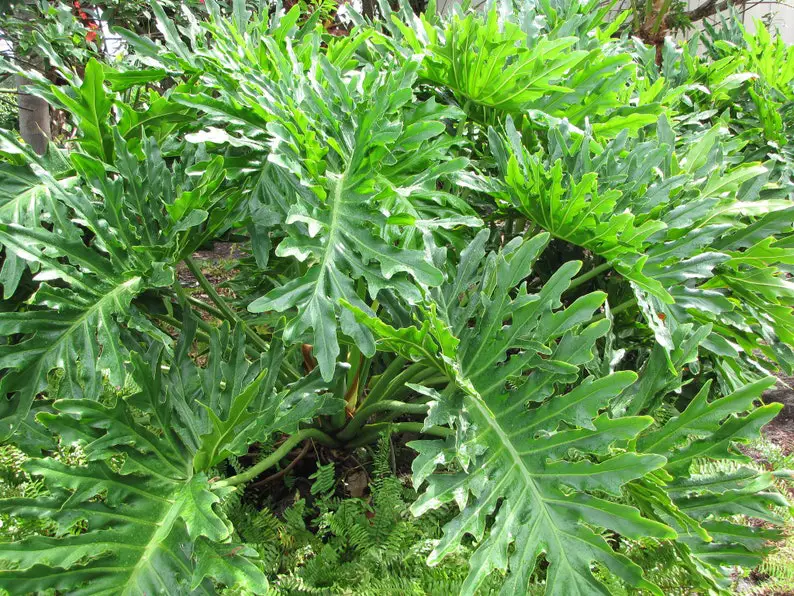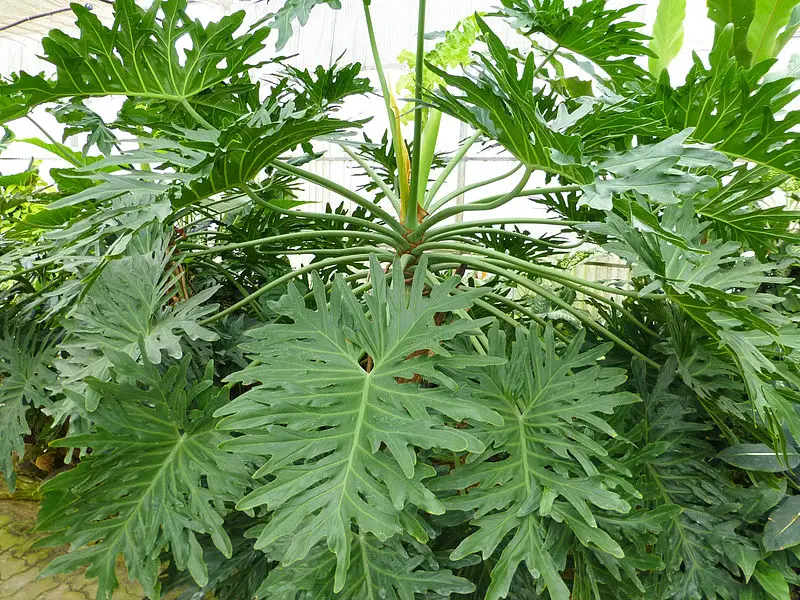Philodendron selloum (philodendron sello)is a very interesting plant with beautiful leaves, which will ideally decorate a large bright room. It also perfectly cleans the air by absorbing toxic substances and destroying harmful microbes.

philodendron selloum Description
Philodendron belongs to the genus of evergreen flowering perennials and belongs to the Aroid family. In the wild, these plants are most commonly found in the humid tropical climates of Mexico and America. They grow both in forests and in swampy areas, on river banks, along roads. Philodendrons can climb other plants and trees using their aerial roots. For this, they got their name, which is translated from the ancient Greek language as a combination of the words “love” and “tree”.
Philodendrons have aerial and underground roots. The former are needed for them to attach to trees and plants, as well as to transport water and nutrients. Leaves of different shades of green are located alternately, are large (up to 2 m) and varied in shape, which at a young age may differ from the shape of the leaves of an adult plant. The inflorescence is a white ear with a thick bicolor blanket.
The fruit of the philodendron is a white berry with a greenish tint.
philodendron selloum Habitat
philodendron selloum has another name: double-feathery. In nature, he lives in the forest tropics of Bolivia, in the south of Brazil, in the northern part of Argentina. It has a straight, short woody trunk, on which traces of fallen leaves form beautiful patterns. Leathery leaves are arrow-shaped, twice pinnately dissected, up to 90 cm in length. They are green with a gray tint and with long petioles. Nowadays, the Sello philodendron is often grown as a showy greenhouse and houseplant.
philodendron selloum Care
Philodendron selloum is a not very difficult houseplant to grow. But you should know that he needs large spaces for good growth. In addition, its juice is poisonous, so only cut the plant with gloves and protect children and pets from contact with it. To grow a healthy, beautiful plant, carefully study the rules of care.
Lighting
The plant loves bright, diffused light. From excess illumination, the leaf plates turn pale. Do not expose the leaves to direct sunlight, otherwise, burns are inevitable. With insufficient light, the leaves fade and lose their decorative effect.
Temperature
Philodendron Sello feels great at a temperature of + 17– + 25 ° С. In winter, the ideal temperature regime is not lower than + 14 °. He needs regular ventilation of the room, but drafts are destructive for this plant.
Air humidity
This representative of the tropics loves high humidity (about 70%). Spray the philodendron daily using a fine spray to keep the leaves streak-free. To increase air humidity, you can place the plant on a tray with moistened pebbles or place an aquarium next to it.
Watering
Abundant and frequent watering with soft, settled water at room temperature is recommended. The soil should always be slightly damp. Be sure to drain excess water from the pan to prevent root rot.
Fertilizing
In the spring-summer period, it is necessary to apply special fertilizers for plants with decorative foliage 2 times a month.
Pruning
In the spring, the philodendron is cut below the zone of the upper tier at the aerial roots, leaving a small stem. It is recommended to pinch the shoots above the upper internodes so that the plant does not grow much. Aerial roots can be shortened slightly, but cannot be cut. They should be directed downward and buried.
philodendron selloum Transplanting and repotting
Actively growing young philodendrons need an annual transplant, adult plants need to be transplanted every few years. You can purchase a special primer for these plants, or mix equal amounts of orchid and peat primer. If you want to prepare the mixture yourself, then take:

- 1 piece of turf;
- 3 pieces of leafy land;
- 1 part sand.
Don’t forget to drain.
Propagation of philodendron selloum
This species is difficult to propagate by cuttings since it has practically no stem. Therefore, the philodendron Sello “Mexican serpent” is grown from seed. They can be purchased at specialized stores. Try to grow a philodendron from seeds at home using the following algorithm:
- soak the seeds for a day in a solution with growth stimulants (for example, with potassium humate, HB-101);
- scratch the seeds with a sharp needle to damage their shell;
- in a container with loose earth, previously calcined and spilled with boiling water, put the seeds on the surface;
- lightly sprinkle them with an earthen mixture and sprinkle with a spray bottle;
- cover the top with a transparent bag or glass;
- Place your mini greenhouse in a warm place with good lighting.
- ventilate the greenhouse every day, leaving it open for a few minutes, and moisten the soil so that it does not dry out;
- when the seeds germinate (after about 1.5–2 months), remove the package and continue leaving;
- dive seedlings only when a couple of real leaves appear on the plants.
Philodendron is a perennial plant brought to our country from America. They are thermophilic plants, so they feel comfortable in apartments and greenhouses. Plants are divided into two groups – vines and tree-like.
Growing a plant from seeds
philodendron selloum seeds are purchased from a specialized store. Before planting, they must be soaked in a growth stimulator to improve germination for 24 hours.
The pots must be filled with calcined sand and watered abundantly. Put the seeds on the surface of the sand and moisten them with a spray bottle. Cover the containers with polyethylene and place in a warm, well-lit place.
Polyethylene must be removed for a few minutes daily to ventilate the seedlings. The first shoots will appear in 45-60 days. After the emergence of seedlings, the polyethylene is removed for a longer time so that the seedlings get used to the air. If the seedlings have two true sheets, the polyethylene is removed, the sprouts are planted in separate pots. Plants are transplanted after a year.
philodendron selloum Diseases and pests
Thanks to its poisonous cell sap, the plant is not susceptible to disease. However, this does not frighten pests. Philodendron is attacked by the following pests:
- Scabbard – Brown formations on stems and leaves that suck out cell sap. Signs of the appearance of this pest are yellowing and leaf fall. To combat the pest, the plant is wiped with a sponge with foam of laundry soap or treated with Confidor;
- Thrips — Small insects that appear as small light dots on the surface of a leaf. To combat this pest, it is necessary to replace the top layer of earth 10 cm thick. Treat the plant with Fitoverm;
- Spider mite — you can recognize the appearance of this pest by a thin web in the internodes and on the stems. The leaves of the plant wither and fall off. To combat this pest, a thick foam of laundry soap is applied to the leaves and stems. If necessary, treat with Aktelik;
- Mealybug — When a pest appears, light lumps appear on the surface of the leaves, resembling dirty cotton wool. The plant must be wiped with a napkin moistened with medical alcohol and rinsed with a hot shower. If necessary, treat with Karbofos.
Adhering to all the recommendations for cultivation and care, even novice growers can grow a Philodendron.